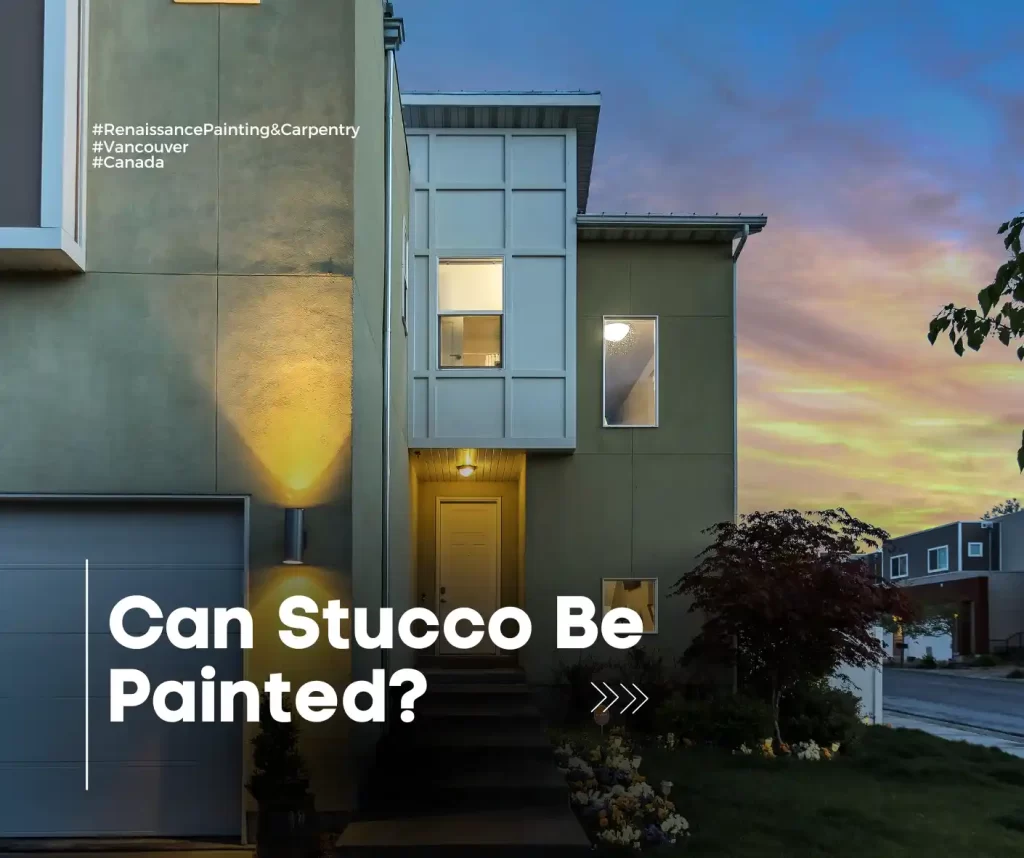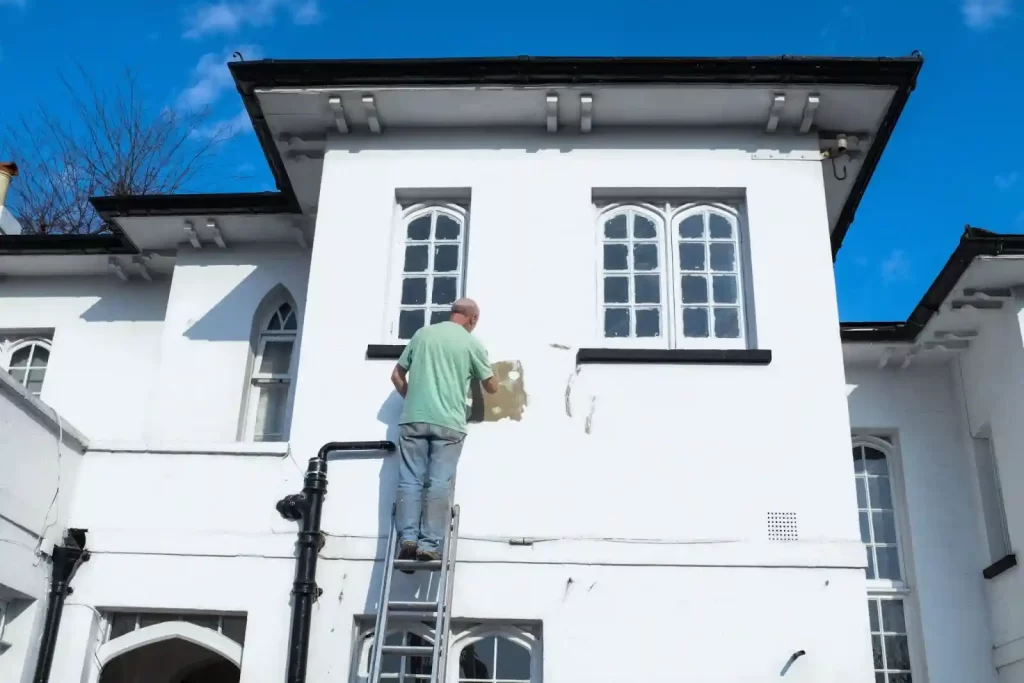
If you currently have a stucco house or considering a stucco home, you may be wondering if you can paint stucco.
Yes, stucco can be painted. In fact, we highly recommend it!
Still, don’t plan a trip to the paint store just yet. Painting a stucco exterior is more complex than most people think, and even small mistakes can cause costly repairs down the line.
- Understanding Stucco
- The Benefits of Painting Stucco
- How to Paint Stucco: An Overview
- Painting the stucco
- Get a FREE Quote on Stucco Painting
- FAQs
Understanding Stucco
Stucco is a type of exterior finish made from a mixture of cement, sand, water, and other materials such as lime or acrylic polymers.
The use of stucco for masonry surfaces dates back over 9,000 years – as far back as Ancient Greece, where off-white stucco temples were the norm.
Even today, low-maintenance stucco is one of the top choices among Vancouver homeowners. The city is home to countless stucco walls, stucco siding, and other types of stucco exteriors and interiors.
The Benefits of Painting Stucco

Modern stucco paint, especially elastomeric paints, protects and preserves stucco in several ways:
Paint weatherproofs stucco
Preventing moisture damage is critical for stucco because it’s such a porous material. This is particularly important in Vancouver, where the city receives an average of 160+ rainy days per year.
When you paint stucco, you’re sealing the pores, found in stucco so that moisture can’t seep in. It also offers protection against UV rays, salt (if you live near the water), and other pollutants.
Painting stucco can improve your home’s insulation
Stucco is a breathable material that can absorb and release heat quickly. This is a double-edged sword: in the summer, it can help keep your home cool by releasing heat quickly, but in the winter, it can make it difficult to keep your home warm.
Paint can help slow down the transfer of heat through the stucco, boosting the energy efficiency of your property.
Paint fills in and helps prevents cracks in stucco
Hairline cracks in stucco can form due to a variety of reasons, including the natural settling of your home’s foundation, temperature changes, moisture exposure, and improper application of the stucco wall.
Exterior painting naturally fills in these spaces so they don’t turn into large cracks. The paint can also help keep the stucco from expanding and contracting, thus preventing new cracks from forming.
Painting stucco covers up stains
There are several types of aesthetic imperfections that can occur in stucco homes, including:
- Efflorescence: This is a white, powdery substance that appears on the surface of stucco due to the presence of salt deposits. It can be difficult to remove and can make the stucco look dull and dirty.
- Fading: Over time, exposure to sunlight and other elements can cause the colour of the stucco to fade, making it look old and worn.
- Discoloration: Stucco can also become discolored due to weathering, mould and mildew growth, or exposure to pollutants.
A fresh coat of paint can quickly and effectively cover up these imperfections while helping to prevent future staining.
Paint is a cost-effective way to refresh stucco
Applying fresh paint to stucco is a high-impact, affordable option to boost the curb appeal of your home.
The colour spectrum for exterior stucco paints is practically limitless – go contemporary, neutral, bold, or something completely custom. Stucco can also be painted to visually match materials like wood, tile, and more.
Not sure how to start? Use these tips to pick paint colours like a pro.
How to Paint Stucco: An Overview

As you can see, painting your stucco offers serious benefits – but only if it’s done right. Here’s a peek at how we do it as professional painters:
Inspecting the stucco for issues
First, we’ll visit your home to conduct a detailed inspection of your exterior stucco. We look for issues like:
- Cracks and other structural damage
- Trapped moisture
- Mould and mildew
- Pests
We can fill larger cracks and repair most stucco damage ourselves. But for other issues, such as extensive pest infestations, we recommend hiring a specialist.
Choosing the right paint
There are several types of exterior paint that can be used on stucco, including acrylic paint or acrylic latex paint, elastomeric paint, and masonry paint. As for the finish, you have some options too, such as matte or flat sheen, and eggshell.
That’s why we spend a lot of time going over stucco paint options with our clients. It’s not just about the colour – we also consider compatibility with the stucco type and other factors like location. For example, if you live near the ocean, you’ll want stucco paint that can withstand the corrosive salt air.
We also take into account the architectural style of the home and the surrounding environment. A modern home may look best with a sleek, neutral stucco colour, while a Spanish-style home may benefit from a warm, earthy tone.
Cleaning the stucco surface
This phase involves removing dirt, grime, and other pollutants from the stucco surface using a pressure washer and other tools. We’ll also scrape off any loose or flaking paint and patch any crack we find.
Priming the stucco surface
In some cases, we may also apply a coat of primer before painting exterior walls made of stucco. Primer helps exterior paints stick better and further seals small cracks or pores on stucco surfaces.
The type of primer we use will depend on the condition of your stucco. For example, if the stucco is new, a bonding primer may be used to ensure proper adhesion of the paint.
If the stucco has stains or discolouration, a stain-blocking primer may be applied to prevent them from bleeding through the paint.
Painting the stucco
When painting stucco, our goal is to bring out that gorgeous texture while making sure the paint looks amazing and lasts for a long time.
To do that, our stucco painting process includes the following:
- Using professional painting tools like airless sprayers and medium nap rollers, especially for larger areas
- Applying at least two coats as the stucco’s porous surface will absorb the first few coats
- Cutting in the paint precisely into architectural details like light fixtures, mouldings, around windows and doors, and other designs
- Painting stucco is very messy – we’re careful about protecting areas such as windows and walkways with plastic, masking paper, tape, and drop cloths
Of course, we customize this process for every project’s special requirements.
Get a FREE Quote on Stucco Painting
Breathe new life into your home with Renaissance Painting! Our team can handle any type of exterior painting project, from vinyl to brick, cedar, and yes – stucco.
Every job is unique, so we like to start off with a personal conversation. Call us today or fill out this form to tell us all about your project – why you want to repaint, the results you want to see, and other things you’d like us to know.
We also created this guide to exterior house painting costs to help you plan your budget in the meantime.
FAQs
What kind of paint do you use on stucco?
We recommend using acrylic masonry paint for painting over stucco. It’s specifically designed for masonry surfaces. This type of paint is flexible and will expand and contract with the stucco, preventing cracking and peeling. In some cases, we may recommend elastomeric paint instead.
Can you paint directly on stucco?
Yes, you can paint directly on stucco if it’s cured. For best results, prep and clean the surface, and only use high-quality paint.
What are the cons of painting stucco?
First is the cost – painting stucco requires a lot more paint due to its highly textured and porous surface.
Another is that preparing stucco for painting can be quite complicated. You need to make sure it’s cured, in good condition, and any structural damage fixed before it’s ready for painting. It’s easy to miss these issues if you don’t have experience painting stucco.
What is the best way to paint over stucco?
The best way to paint over stucco is to use a high-quality roller or sprayer for the best coverage and a stiff brush for cutting in. Here’s our guide to rolling vs. spraying for further guidance.

